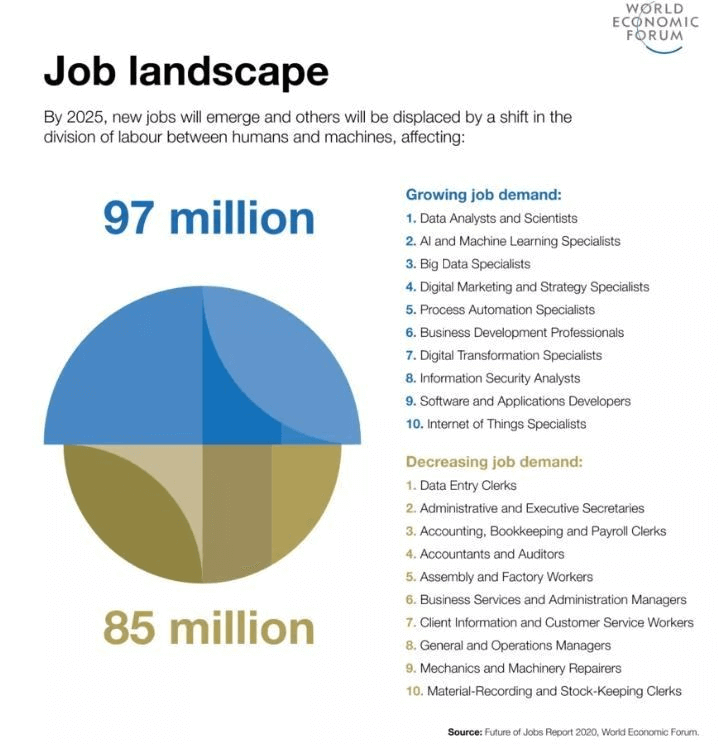How AI Enables Upskilling, Reskilling, Continuous Learning
We all have witnessed the crazy adoption of ChatGPT, and it has now been a daily driver for several industries — be it content or development.
Although the tool has helped in the mainstream adoption of AI, but it has also instilled fear of losing jobs.
The internet is filled with listicles like “10 jobs that AI will replace by 2030,” and the fear is real.
AI is a double-edged sword; in addition to the fear of stealing jobs, AI can help solve the job problems it is touted to create.
For instance, AI has helped in creating job sites like SkillGPT that connect job seekers with recruiters who are passionately looking for people with their skill sets.
The platform offers curated recommendations of candidates with the skills that the job role requires.
Moreover, AI can also assist in upskilling the continuous learning of employees which can help in safeguarding their careers from future disruptions.
Curious to know how? Read to the end of the article.
Why Should Businesses Invest in Upskilling Their Workforce?
In addition to investing in the latest technology, businesses must also invest in employee training.
According to the Workplace Learning report by LinkedIn, 89% of learning and development professionals believe that upskilling employees is crucial to navigating the ever-changing future of work.
To ensure the successful adoption of AI in the workplace, employers need to provide learning opportunities that lead to upskilling and reskilling.
In this way, they can mitigate the potential resistance from employees and foster a healthy human-AI collaboration.
Continuous Learning Needs Generative AI
Even the employees must be willing to stay updated with the latest trends and exhibit the zeal to improve continuously.
As AI gradually gets better (and faster) at performing technical and creative tasks, there will be a spike in demand for robust communication and soft skills.
So on top of technical skills, employees will also need to buckle up their collaboration and leadership skills to stay competitive.
Businesses should be mindful of these factors while crafting their learning and development (L&D) programs.
The programs should be crafted in a manner that results in the holistic growth of their employees.
Drawbacks of the Existing Learning and Development Programs
It is clear that businesses need to invest in upskilling their workforce to maximize profits and productivity.
However, the conventional methods of learning and development (L&D) programs come with several pitfalls that hinder overall success.
Let us explore them in detail:
Generic Curriculum
Everyone has different preferences for learning (such as video and text) and grasping power.
Sadly, traditional learning and development programs attempt to use the “one-size-fits-all” approach.
The courses are usually created once and seldom updated. Plus, they offer little to no customization.
Learning Format
With the advent of TikTok and reels, people’s attention span is at an all-time low!
In comparison, the traditional learning materials are in a long format like webinars, PowerPoint presentations, which makes it challenging to learn and retain the information.
Measuring Impact
Several businesses still prefer the classic instructor-led method of delivering the L&D sessions. The downside is that it is time-consuming and challenging to track the sessions’ impact.
How Can AI Augment the Continuous Learning and Development Process?
Now that we are clear on the shortcomings of traditional L&D models, let us address the elephant in the room, i.e., how AI can help solve them.
Microlearning
The training materials need to be short and to the point to instill the learning into the daily workflow. Microlearning can help with that.
Microlearning is all about providing small bits of knowledge pieces instead of an hour-long session.
There are several AI-based platforms that leverage microlearning for L&D. One such platform is Axonify, which focuses on training frontline staff.
With Axonify, businesses can create short pieces of content which can be consumed anytime and even through mobile devices.
For example, bank staff can watch a short clip on the process of daily operations like credit card pre-approval.
It also serves as a knowledge base so that the associates can get answers to pressing questions.
Plus, it also offers tests to reinforce the information being taught and gamifies the entire process through leaderboards.
Through gamification, even employees feel motivated to learn.
Axonify also uses “adaptive learning” to personalize the learning experience for each employee. And it can be further customized based on their topics of interest.
Enhanced Analytics
The AI tools can evaluate the answer sheets and candidates’ performance. This reduces human error and offers accurate results.
It also helps quickly identify the learners’ knowledge gaps and ensures that the continuous learning goals are met.
With AI, businesses can understand the course completion time and preferred learning methods.
Then, all this data can be used to optimize the learning materials for maximum efficiency.
Virtual Reality (VR)
Virtual reality has been in the news lately, especially after Apple announced Vision Pro.
The device delivers an immersive experience to the wearer by blending the real and virtual worlds.
Thanks to VR, you can not just capture your moments in the video but also experience depth.
For example, you can shoot your kid’s first birthday. And then you can revisit the moment where you can witness the incredible depth of the cake and the burning candles — as if you are experiencing it for the first time.
On top of personal use, VR also has fantastic use cases when it comes to upskilling the workforce — especially in the healthcare industry.
Employees can be trained to perform complex surgeries using VR simulations.
There are also Operator Training Simulators (OTS) that provide a learning environment identical to the real one.
And they can be used to train operators that handle heavy machinery.
In the nuclear industry, even a slight mistake can have massive repercussions. With virtual simulations, the chances of fatal injuries can be minimized during the learning process.
Bias Reduction
Going with the instructor-led approach can invariably contain biases which can hamper the overall efficiency of the L&D program.
For example,, the instructor can exhibit bias towards certain genders or certain employees during training. This can breed partiality.
AI-based training is free from such biases and prejudices. It instructs and evaluates all the candidates on fair grounds.
Even the personalized learning recommendations are backed by the actual usage data of the users.
Increasing Accessibility
When it comes to employment, the Americans with Disabilities Act (ADA) prohibits businesses from discriminating against people with disabilities.
As businesses become more inclusive, it is crucial to make the learning materials accessible to all kinds of learners. Fortunately, AI can help with this.
For example, Google provides the “Live Caption” feature in the chrome browser that makes it accessible for people with hearing impairments to comprehend video content.
It automatically creates captions for any video being played on the browser.
Likewise, Google has the feature of image descriptions in Chrome. It can describe the content of images and be a game-changer for people with blindness.
With such AI tools, businesses can make their L&D programmers accessible to the masses.
Embracing the Future with AI
It is evident that upskilling the workforce is not an option but rather a necessity to survive in the competitive landscape.
Throughout the article, we have witnessed how AI can revolutionize the HR industry, especially in upskilling the workforce.
Brands such as Dell use AI for their “Learning Studio” to train their employees about future skills, compliance training, and soft skills.
Rather than thinking of AI as a competitor for the human workforce, it should be leveraged as a colleague to elevate their skills and enhance their performance.


